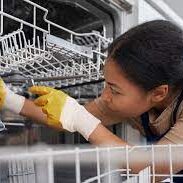Automatic dishwashers offer more than just convenience. They save time, reduce physical effort, minimize dish breakage, and help maintain a tidy, clutter-free kitchen. For institutions like hospitals and food service facilities, dishwashers are essential to meet public health standards, often required by law for sanitation.
However, the full benefits of a dishwasher along with specially formulated detergents can only be achieved through proper use. Understanding how a dishwasher functions, how to load it correctly, and how to operate it according to manufacturer instructions is key to maximizing its performance.
How Dishwashers Work
The primary role of a dishwasher is to use mechanical action to circulate detergent and rinse water across dishes, effectively loosening and removing food soils. It also removes dirty water after each cycle phase and dries the dishes at the end.
Washing Systems
- Dishwashers differ in design: some feature a single water source, while others have multiple. Water is distributed through spray arms, towers, or impellers, which vary in size, shape, and placement. Machines with fewer water sources require careful loading to ensure dishes do not block the spray and compromise cleaning efficiency.
The Role of Water
- Amount: Dishwashers use far less water than many assume is usually 6 to 10 gallons per cycle. Unlike clothes washers, they operate with small, strategic fills throughout the cycle. To avoid reduced cleaning efficiency due to low home water pressure, limit simultaneous water-heavy tasks like showers or laundry while the dishwasher is running.
- Temperature: Water temperature is critical. It should reach at least 130°F (54.4°C) for optimal detergent activation, soil removal, and drying. Lower temperatures may lead to greasy residue, spotting, and poor drying results.
- Hardness: Hard water, which contains minerals and dissolved solids, can interfere with cleaning performance. It may reduce detergent effectiveness, promote spotting, and leave filming on dishes.
To get the most from your dishwasher, it’s not just about pressing “start” but about understanding how it works, loading it correctly, using the right water temperature, and adjusting for water conditions like pressure and hardness. By following best practices and the manufacturer’s guidance, you’ll ensure sparkling results, longer-lasting equipment, and a more hygienic kitchen environment.








